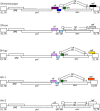Species tropism of HIV-1 modulated by viral accessory proteins
- PMID: 22855686
- PMCID: PMC3405772
- DOI: 10.3389/fmicb.2012.00267
Species tropism of HIV-1 modulated by viral accessory proteins
Abstract
Human immunodeficiency virus type 1 (HIV-1) is tropic and pathogenic only for humans, and does not replicate in macaque monkeys routinely used for experimental infections. This specially narrow host range (species tropism) has impeded much the progress of HIV-1/acquired immunodeficiency syndrome (AIDS) basic research. Extensive studies on the underlying mechanism have revealed that Vif, one of viral accessory proteins, is critical for the HIV-1 species tropism in addition to Gag-capsid protein. Another auxiliary protein Vpu also has been demonstrated to affect this HIV-1 property. In this review, we focus on functional interactions of these HIV-1 proteins and species specific-restriction factors. In addition, we describe an evolutional viewpoint that is relevant to the species tropism of HIV-1 controlled by the accessory proteins.
Keywords: HIV-1; Vif; Vpu; accessory protein; species tropism.
Figures




References
LinkOut - more resources
Full Text Sources

